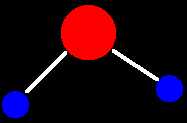Synthesizing Water
 The
ubiquitous water molecule is often taken for granted, but its chemistry is extremely
fascinating. I plan for this to be the first of several pages devoted to water and its
ingredients; hydrogen and oxygen. Water molecules can be made by combining hydrogen gas
molecules with oxygen gas molecules preferably in a two to one ratio according the
following recipe:
The
ubiquitous water molecule is often taken for granted, but its chemistry is extremely
fascinating. I plan for this to be the first of several pages devoted to water and its
ingredients; hydrogen and oxygen. Water molecules can be made by combining hydrogen gas
molecules with oxygen gas molecules preferably in a two to one ratio according the
following recipe:
2H2(g) + O2(g) ----> 2H2O(g)
When my students see me write this equation for the first time, they
will inevitably inquire as to why I labeled the water as gaseous. This is easily answered
by showing them the reaction. Those water molecules are HOT! Of course they can lose
kinetic energy quickly, have sticky collisions with a series of relatives, and find a nice
place to land as part of a newly condensed drop. The equation looks too simple to be
interesting, but the reaction is fast and explosively energetic. The ignition temperature
for the reaction is 580-590*C. The reaction produces 232 KJ per mole of water formed. My
source for the the hydrogen and oxygen gases used in experiments B-E are the compressed
gas cylinders pictured below. The large cylinder contained 197 cubic feet of
industrial-grade hydrogen and the small cylinder contained 125 cubic feet of
industrial-grade oxygen.
 A: Hydrogen-Powered
Soda Bottle Rockets (3 K)
A: Hydrogen-Powered
Soda Bottle Rockets (3 K)
B: Making Water in a Water Bottle (1 K)
C. The Hydrogen Cannon (12 K)
D. Making Water in a Milk Jug (19 K)
E. Hydrogen Balloons (26 K)
 The
ubiquitous water molecule is often taken for granted, but its chemistry is extremely
fascinating. I plan for this to be the first of several pages devoted to water and its
ingredients; hydrogen and oxygen. Water molecules can be made by combining hydrogen gas
molecules with oxygen gas molecules preferably in a two to one ratio according the
following recipe:
The
ubiquitous water molecule is often taken for granted, but its chemistry is extremely
fascinating. I plan for this to be the first of several pages devoted to water and its
ingredients; hydrogen and oxygen. Water molecules can be made by combining hydrogen gas
molecules with oxygen gas molecules preferably in a two to one ratio according the
following recipe: